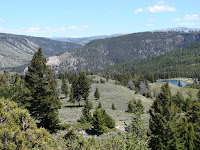 |
| Headwaters of the Missouri River - Madison River on left merges with Jefferson River on right to form the Missouri |
 |
| Headwaters from a higher viewpoint |
 |
| Gallatin River - it joins in a mile downstream in distance |
The official headwaters is where the Madison and Jefferson Rivers join together and about a half mile downstream the Gallatin River also joins. All three of these rivers are fairly good size which gets the Missouri off to a substantial start from it's very beginning. Over the last month we have become familiar with the Madison and Gallatin Rivers because they both start from within Yellowstone at or near the Continental Divide and roads run along them for miles. It was interesting to learn that the end of those formed the Missouri. Seeing the size of both the Madison and Jefferson Rivers I immediately wondered why Lewis and Clark gave them new names rather than just saying one of them was the Missouri (probably the Jefferson because it heads more westerly which was their objective). It appears that question was debated by them and they decided to go with this being the start of the Missouri so they gave new names to the rivers they found. I had always imagined a small stream slowly growing larger and larger to form the Missouri River but that is not the case unless we consider the origins of the Madison and Jefferson Rivers. Here is a link to the Wikipedia write-up for this state park. It references the debate.
http://en.wikipedia.org/wiki/Missouri_Headwaters_State_Park
 |
| Remains of Gallatin City - hotel on left |
Bonus picture for today. We saw some beautiful Cedar Waxwings while walking around the state park.
 |
| Cedar Waxwing |
For the fun of it, below is a picture of the Madison River in Yellowstone National Park about one mile straight east of the town of West Yellowstone. It is not very deep here but it is quite wide. Elevation here is about 6600 feet versus around 4000 feet when it flows into the Missouri.
 |
| Madison River in Yellowstone National Park |

































